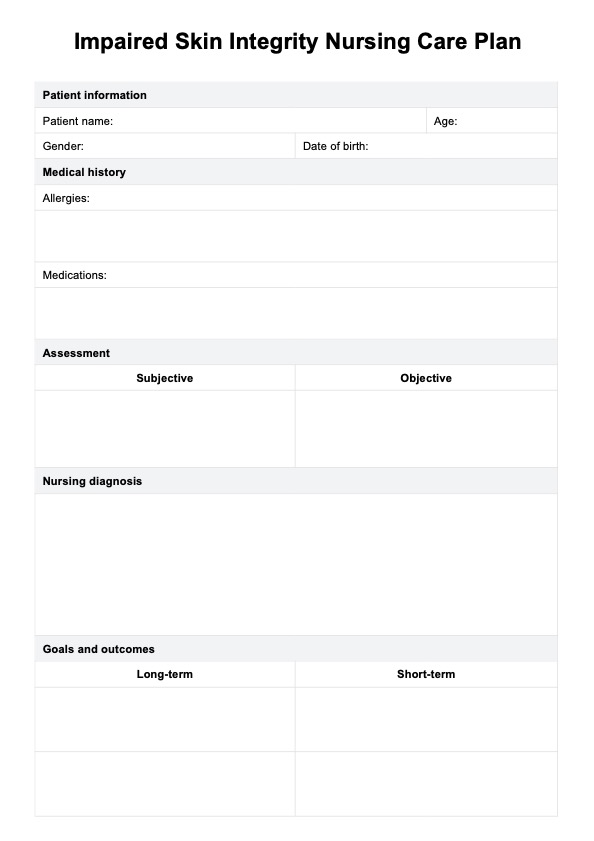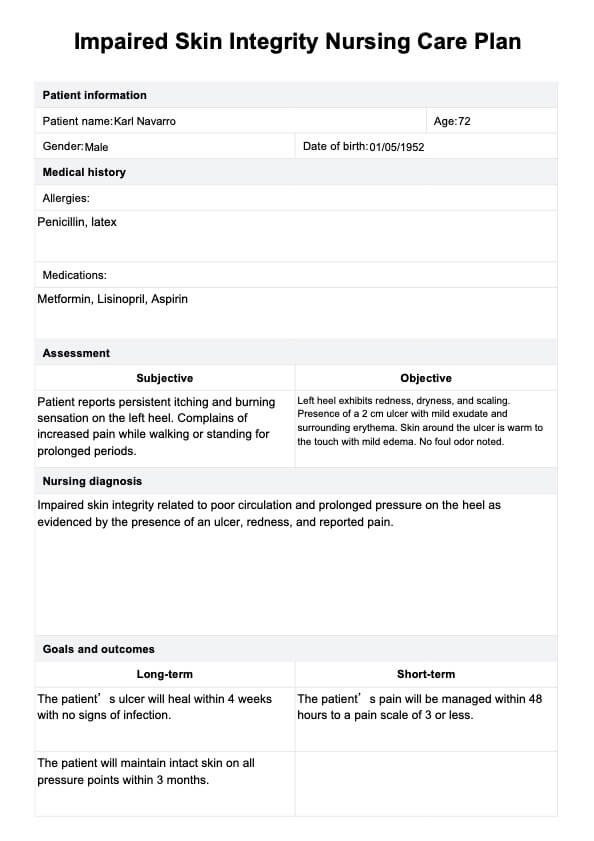Impaired Skin Integrity
Download our Impaired Skin Integrity Nursing Care Plan Template to improve patient care—evidence-based interventions for positive outcomes.

By Joshua Napilay on Sep 02, 2024.


Table of content
What is impaired skin integrity?
Impaired skin integrity refers to damage or alteration to the skin that disrupts its normal protective function, compromising its ability to act as an effective barrier. This condition involves epidermis and/or dermis alterations, leading to compromised skin structure and function. Various factors impair skin integrity, including external and internal factors promoting skin health.
Internal factors such as poor nutrition, edema, impaired circulation, neuropathy, and chronic conditions like diabetes can affect the healing process and contribute to acute and chronic wounds. External factors, including pressure injuries, friction, moisture, radiation, chemicals, and physical trauma from surgical procedures, also play a significant role in poor wound healing. These factors can exacerbate skin irritation, promote further skin damage, and impact wound healing, ultimately undermining the skin’s ability to maintain intact skin and promoting poor wound healing.
Signs and symptoms
Recognizing signs early is crucial for managing impaired skin integrity effectively, which includes treating the condition, promoting wound healing, and employing appropriate wound care strategies to treat impaired skin integrity and prevent further skin damage. The following indicators and manifestations may be present:
- Changes in skin color, such as redness, bruising, or blanching
- Open areas, wounds, or skin breakdown
- Pain, itching, or altered sensation in affected areas
- Warmth, swelling, or inflammation of the skin
PDF Template
Example PDF
Impaired Skin Integrity Template

Impaired Skin Integrity Example

What is an Impaired Skin Integrity Nursing Care Plan template?
An Impaired Skin Integrity Nursing Care Plan template is designed to address the needs of patients experiencing compromised skin health.
The template guides healthcare professionals to assess, plan, implement, and evaluate the care provided to patients with impaired skin integrity tissue healing. It typically includes several key components:
- Assessment: This involves thoroughly examining the patient's skin and identifying any existing wounds, lesions, or areas of concern. Factors contributing to skin impairment, such as immobility or poor nutrition, are also considered.
- Diagnosis: The nursing diagnosis for impaired skin integrity is established based on the assessment findings. This could involve identifying specific wounds, grading pressure ulcers, or diagnosing dermatological conditions.
- Planning: Goals and outcomes are set to guide the care process. This may include preventing further skin damage, promoting wound healing, and addressing underlying causes of skin impairment.
- Interventions: Specific nursing interventions are detailed to address the identified issues. This could involve wound care, infection control, pain management, and strategies to prevent pressure ulcers or skin breakdown.
- Rationale: The rationale for each intervention is provided, including evidence-based practice and best practices in skin care.
- Evaluation: The effectiveness of the interventions is assessed, and adjustments are made to the care plan as needed. Progress towards established goals is monitored.
How does it work?
Here are the following steps to effectively use the template:
Step 1: Download the template
Begin by downloading the printable template to document each step of the care plan.
Step 2: Assess the patient’s skin integrity
Evaluate the patient’s skin for wounds, lesions, or compromised dry skin areas. Consider factors surrounding skin, such as immobility, malnutrition, and medical conditions affecting skin health.
Step 3: Establish a nursing diagnosis
Based on your assessment, formulate a diagnosis of impaired skin integrity. This may include categorizing wounds, grading pressure ulcers, or identifying specific dermatological conditions.
Step 4: Set goals and plan interventions
Define specific goals for wound bed: preventing skin damage, promoting wound healing, and addressing underlying issues. Develop a plan with targeted nursing interventions, including wound care, infection control, pain management, and pressure ulcer prevention.
Step 5: Implement and document interventions
Carry out the planned interventions, provide hands-on care, administer medications, and implement preventive measures. Use the template to document assessment findings, diagnoses, goals, interventions, rationale and evalution. Regularly evaluate and adjust the care plan as needed and communicate with other healthcare professionals involved in the patient’s care.
When would you use this template?
The Impaired Skin Integrity Nursing Care Plan Template is a valuable resource for healthcare practitioners dealing with compromised skin health patients. This template is handy in various clinical scenarios, providing a structured approach to address and manage issues related to impaired skin integrity.
Here are instances when this template is highly relevant and beneficial for practitioners:
- Wound care management: Healthcare professionals, including nurses and wound care specialists, can use the template when managing patients with wounds of various etiologies. It helps develop a comprehensive care plan tailored to the patient's needs.
- Pressure ulcer prevention and treatment: This template becomes crucial when patients risk developing pressure ulcers, such as in long-term care facilities or hospitals. It aids in creating preventive strategies and managing existing pressure ulcers, ensuring a holistic approach to skin integrity.
- Dermatological conditions: Dermatologists and nurses specializing in dermatology can utilize the template to address skin issues caused by various dermatological conditions. It guides the formulation of a care plan combining medical treatments with nursing interventions for optimal outcomes.
- Post-surgical care: Surgical teams and postoperative care providers can employ the template to create a care plan for patients recovering from surgical procedures where maintaining skin integrity is paramount. It ensures a systematic approach to wound care and prevention of complications.
- Long-term care settings: The template is valuable for addressing the unique challenges associated with prolonged immobility, age-related skin changes, and other factors contributing to impaired skin integrity in long-term care facilities, nursing homes, and home healthcare settings.
- Critical care environments: Intensive care unit (ICU) nurses and essential care teams can benefit from the template when managing critically ill patients prone to skin breakdown due to prolonged bed rest, medical devices, or complex medical conditions.
Discover our extensive range of care plans, specialized nursing care plans, and nursing diagnosis templates, all essential for organizing patient care and ensuring effective treatment management. Explore our library to see how these templates can streamline workflows and improve patient outcomes.
Benefits of Impaired Skin Integrity Nursing Care Plan
An Impaired Skin Integrity Nursing Care Plan provides numerous benefits, ensuring comprehensive wound care for patients experiencing poor skin integrity or wounds. Here are the elaborated benefits:
- Prevention of complications: The plan helps prevent complications like infections, pressure ulcers, skin maceration, and further injury due to prolonged pressure or tissue damage by addressing the patient's risk factors and maintaining intact skin.
- Personalized care: The plan's tailored interventions to address specific issues, such as existing wounds, necrotic tissue, or tissue injury, ensuring the patient receives effective and focused care.
- Improved healing: A structured care plan includes regular wound assessment, surgical debridement if necessary, and consistent wound care practices promoting granulation tissue formation and healing.
- Patient education: The plan educates patients and family members about the importance of proper skin care techniques, which aid in maintaining intact skin and promoting the wound's healing beneath the surface.
- Enhanced monitoring: Regular monitoring and documentation of the patient’s skin integrity allow for the early detection of changes, such as signs of tissue damage or the effects of prolonged exposure to risk factors.
- Multidisciplinary collaboration: The care plan fosters collaboration among healthcare providers, including a wound care nurse specialist, to address the patient's skin integrity needs.






